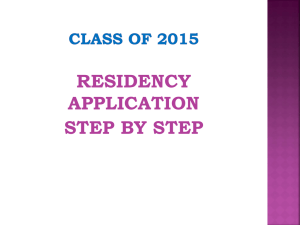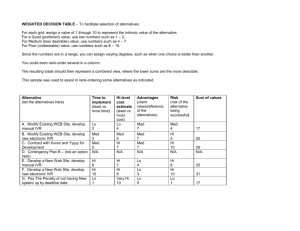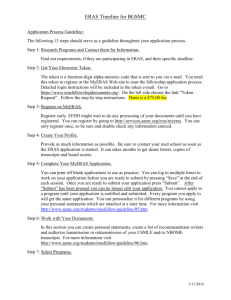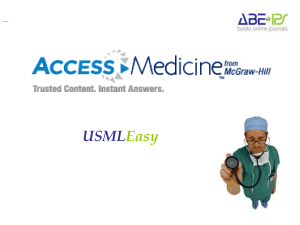An outline for the USMLE Step 1
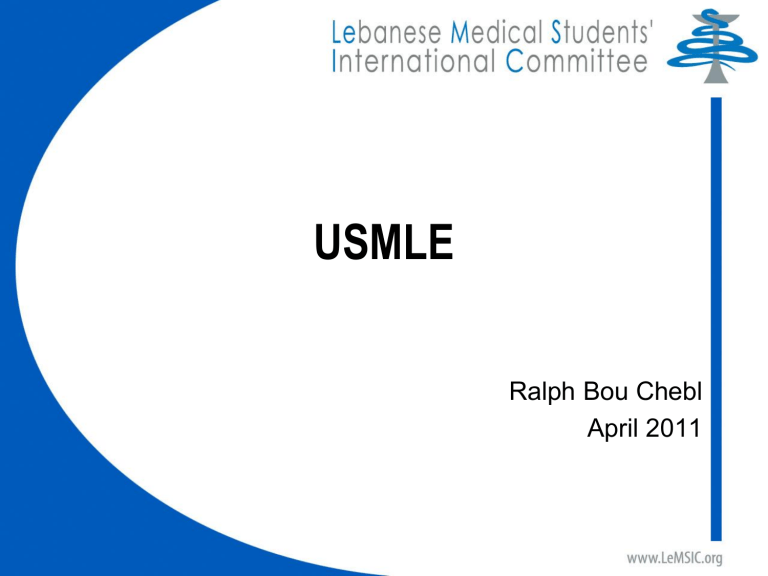
USMLE
Ralph Bou Chebl
April 2011
Basics- Step 1
• Eight-hour computer-based test.
• Seven 46-question sections with a total of
322 multiple-choice questions.
• One hour is the time provided for each section.
• Between test sections, the test taker is allotted a cumulative 45 minutes for personal breaks.
How to register
• Educational Commission for Foreign
Medical Graduates: www.ecfmg.org
• >$800
• 3-month “eligibility period”
• It takes a while to get your permit
• Prometric
• Scores are emailed 3-6 w later
Test questions
• MED-2 = MAJORITY
• One-best-answer (no “excepts,” no matching).
• Experimental questions.
• Imaging, pathology slides.
• Audio questions.
Format and grading
• Three-digit score: 188-???. The three-digit score is calculated using a statistical percentile that ensures that scores from different years are read on a common scale
• Two-digit score: 75-99 (NOT %).
• Mean = 221, SD = 24
• Most scores: 140-260
Subjects
• Anatomy/ Neuroanatomy,
• Biochemistry, Molecular Biology
• Physiology/Pathology
• Microbiology
• Pharmacology and Immunology
• Statistics, Epidemiology, Medical ethics.
How to study
• FIRST AID = Primary reference.
• USMLE World
• The internet
• Board Review Series
• Anatomy, Molecular
Biology, Statistics,
Epidemiology, Medical ethics.
• Class notes
(immunology)
Pathology
• FIRST AID = Primary reference.
• Very high yield subject.
• Main study material for organ systems.
• Slides. CT scans.
Microbiology
• FIRST AID = Primary reference.
• Very high yield.
Bacteriology,
Virology, fungi and
Parasitology.
• Clinical cases.
• Properties of
Bacteria.
• 3 weeks.
Neuroanatomy
• Cross sections.
Identification.
• 2 days.
• Important areas of the brain. Location.
Function.
• Spinal tracts.
Pharmacology
• 7 chapters in
Lippincott’s.
• Pharmacokinetics,
SNS, PSNS high yield.
• 1 week.
• Medication side effects First Aid
Physiology
• Renal and cardiology physiology.
• Understand. Do not memorize.
• Experiments on the step 1.
• Other organ systems, first aid as guide.
Summary
• Most important method to prepare for Step
1 and step 2????
USMLE world
Med 3 Vs Med 4?
• Depends on residency, med 3 schedule, desire to match straight after med 4.
• MED 3: 1. Matching
2. Electives.
3. Don’t REALLY need clinical experience.
• MED 4: 1. Applying to a competitive residency.
2. Easier year than med 3.
3. Clinical clerkships. (scans, clinical presentation). Can be done in 4 months.
Basics- Step 2CK
• Focus is much more on clinical application of medical knowledge
• Eight 44-question sections with a total of 352 multiple-choice questions.
• internal medicine (majority), obstetrics and gynecology, pediatrics, preventive medicine, psychiatry, surgery.
• Diagnosis, prognosis, the next step in medical care, including preventive measures.
Step 2CK - Books
Step 2CK - Books
• Subjects combined in one book.
• High yield topics.
• Important guide for broad material of step
2 CK.
Step 2CK
• Most important preparation method USMLE world.
• When to do it? Study time?
• First 3 months of MED 4 if applying to the match.
(added benefit of MED 3 finals).
• If not matching, better after internal medicine rotation.
Matching
• ERAS Application Process
• Prior to applying via ERAS, contact your programs of interest to determine their minimum eligibility criteria, ERAS application deadlines, licensure requirements , and institutional policies about visas, if applicable. Much of this information can be found on each program’s website. (www.matcharesident.com)
• Obtain a Residency Token via ECFMG’s OASIS .
• Use your Token to register at the AAMC MyERAS website
• Once you have registered at MyERAS, you can begin to work on your application (Profile, CV and Personal Statement).
Matching
• It is recommended that you submit supporting documents , to ERAS Support Services for arrival by
August 1. All documents should be accompanied by a
Document Submission Form (DSF) , which you can complete and print online using ECFMG’s OASIS .
• Register with NRMP in order to participate in the 2011
Match.
• Select programs and assign supporting documents.
• On September 1, at 8:00 a.m., Eastern Time in the
United States, you begin to apply.
Required Documents
• Original Medical Student Performance Evaluation
(MSPE)
• Medical School Transcript
• Original Letters of Recommendation (LoRs)
• Photograph
• USMLE
• Personal statement.
Matching
• 4 categories
1. US citizen, US school.
2. Non US citizen, US school.
3. US Foreign medical graduate.
4. Non US Foreign medical graduate.
Timeline
• Step 1 in MED 3
• Step 2 CK first 3 months of MED 4.
• ERAS token in mid july.
• Apply to ERAS by September 1 st .
• Register for the match at NRMP.
• LORs (3-4). Preferably by US doctors (electives) by
October at the LATEST.
• Interviews (November till end of january)
• STEP 2 CS by December 31 st of application year.
• Match in February.
Timeline
• Post match
• Couple’s match
• Early finals?


